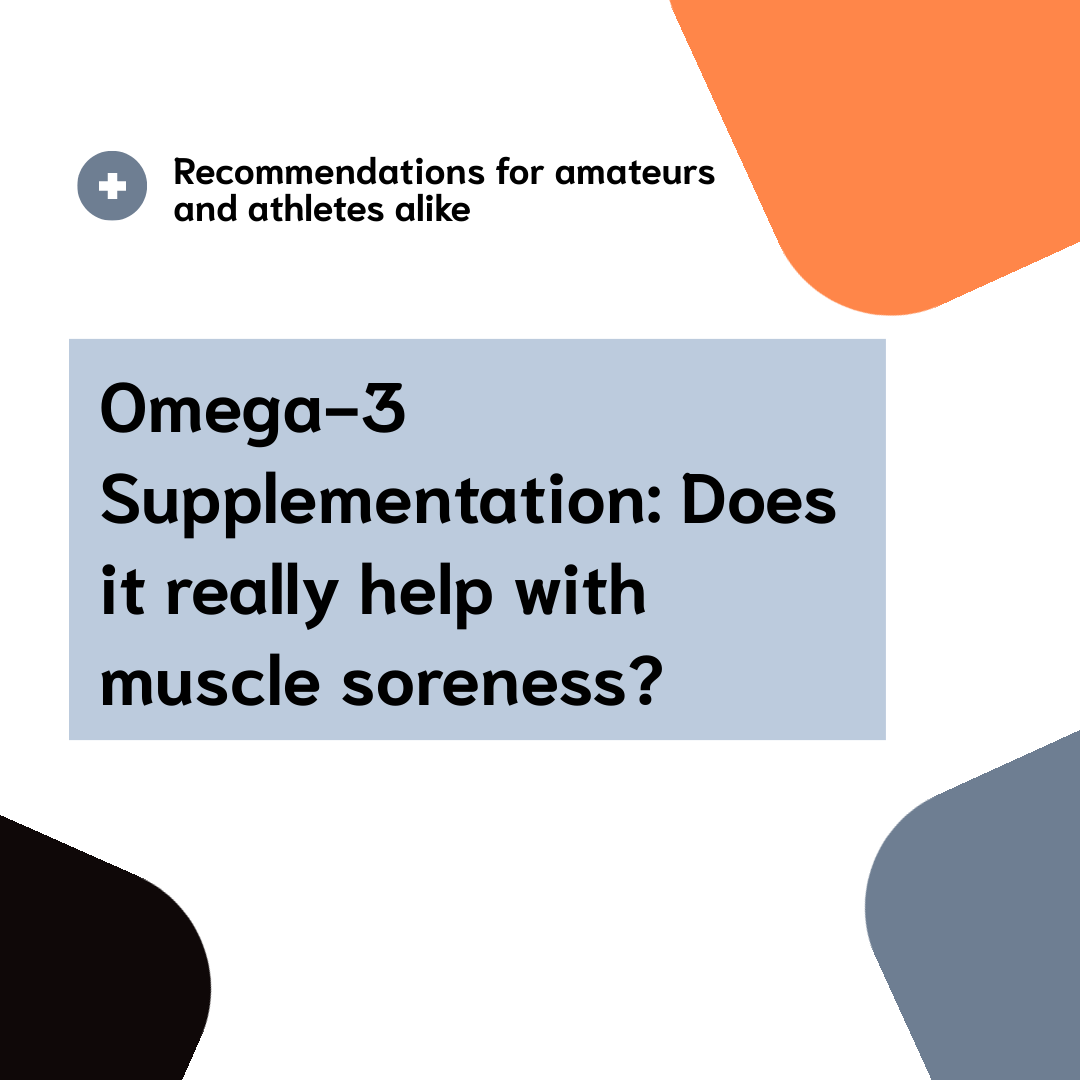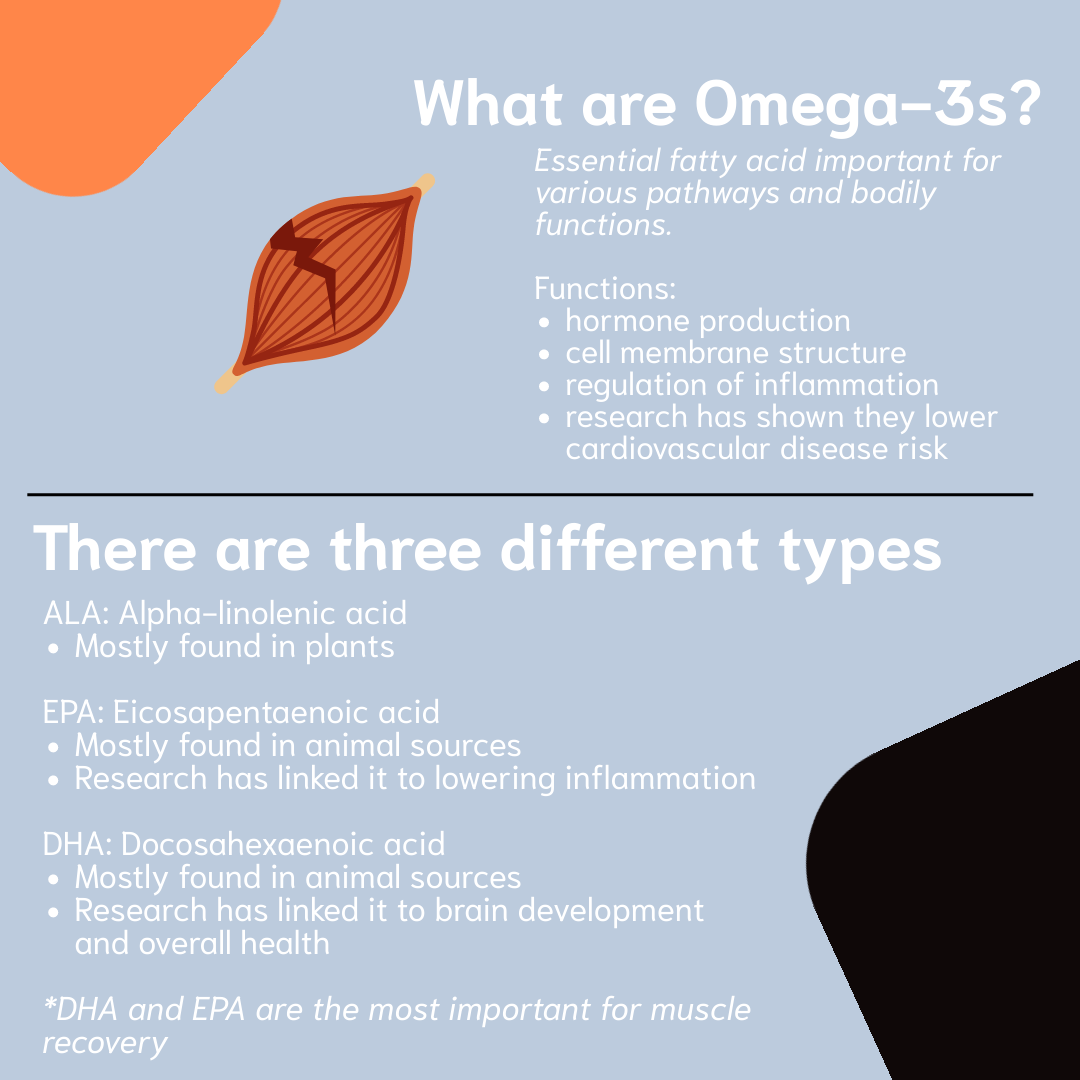Omega-3 Supplements and their Impact on Muscle Soreness and Recovery: Recommendations for Athletes and Amateurs
Written By:
Katy McCary, Dietetic intern at Texas A&M
Edited by Meredith Sorensen, MS, RD, LD Memorial Hermann Sports Medicine Institute
First off, what are omega-3s?
Omega-3 fatty acids are essential polyunsaturated fatty acids that are important for various pathways and bodily functions. Things such as hormone production, cell membrane structure, and pathways that regulate inflammation are all impacted by omega-3 fatty acids. The reason these fatty acids are called “essential” is because we cannot produce enough in our body and must get the rest from our diet. There is newer research that also connects omega-3 intake with cardiovascular health and lowering risk of heart disease as well as lowering blood pressure.1
There are three types of essential omega-3 fatty acids2:
- ALA: Alpha-linolenic acid
- Not very effective
- Mostly found in plants
- Can be converted to EPA and DHA by the body
- EPA: Eicosapentaenoic acid
- Mostly found in animal sources
- Research has linked it to lowering inflammation
- DHA: Docosahexaenoic acid
- Mostly found in animal sources
- Research has linked it to brain development and overall health
We will focus on EPA and DHA specifically in this article as ALA is found more commonly in the diet and most over the counter supplements typically only include DHA and EPA. Additionally, most benefits to athletes are typically seen with EPA and DHA specifically. Recent research suggests DHA provides benefits when it comes to concussion recovery and EPA benefits muscle recovery specifically due to its effects on inflammation.
What are sources of omega-3s?
Food sources include fatty fish like salmon, certain nuts such as walnuts, and things like chia seeds and flax seeds. These are all excellent sources of omega-3 fatty acids but typically not consumed in high enough volume to meet recommended intakes by most Americans. The following chart shows serving sizes and quantity of omega-3s from certain foods.3
|
Food Source |
Serving Size |
mg of DHA |
mg of EPA |
mg of ALA |
|
Salmon (farmed) |
3 oz |
1,240 |
586 |
0 |
|
Sardines |
1 oz |
144 |
134 |
0 |
|
Anchovy |
2 oz |
581 |
343 |
0 |
|
Mackerel |
3 oz |
594 |
428 |
0 |
|
Walnuts |
1 oz |
0 |
0 |
2,570 |
|
Flaxseeds |
7 g (ground) |
0 |
0 |
1,600 |
|
Chia Seeds |
1 oz |
0 |
0 |
5,050 |
What does the research say about Omega-3s and muscle recovery?
In relation to athletes and performance, omega-3s may aid in muscle recovery and reduce soreness due to the anti-inflammatory properties. There is potential for benefit for amateur and professional athletes alike via either supplementation or increasing amount obtained in the diet.
Recent studies have illustrated the effect omega-3 supplementation plays on muscle during activities such as resistance training or any form of eccentric exercise. They have looked at the effects during exercise as well as post exercise and the recovery phase.
One recent publication looked at multiple studies regarding omega-3 supplementation in separate athlete populations specifically looking at effect on markers used to determine the level of exercise-induced muscle damage (EIMD) that occurs after a workout. If these markers are lower post exercise, it might indicate that muscle damage was lower4.
Overall, the review found that omega-3 supplementation greatly reduced biological markers of EIMD. However, just because these enzyme factors were decreased due to omega-3 supplementation, does not necessarily mean it directly impacts inflammation and muscle recovery. The review indicated that supplementation might be more beneficial for untrained or amateur athletes. It was also shown that acute supplementation (1 day) did not have as beneficial an effect on these enzymes as long-term supplementation (1 month). Greater benefit was sometimes shown when either supplementation dosage was higher or the duration of supplement was longer4.
Another study looked at the impact of omega-3 index on performance in healthy active adults. Omega-3 index is a tool utilized to determine how much omega-3 a person has in their blood and has been shown to be a marker for cardiovascular disease risk. An index of 0-4% is associated with the highest risk of cardiovascular related events, 4-8% is associated with intermediate risk, and 8-12% is associated with the least risk of a cardiovascular event5.
The study analyzed a group supplemented with 2.7 g/day of omega-3 fish oil (the study was not specific about the ratio of EPA to DHA) for 30 days to develop an omega-3 index >4% and a placebo group with an index <4%. One important factor tested was delayed onset of muscle soreness (DOMS). DOMS evaluates pain post exercise. This study found that omega-3 supplementation resulted in less DOMS at 72 and 96 hours post exercise indicating that omega-3 supplementation aided in muscle recovery and perceived soreness. It is worth noting that muscle soreness is a perception tool used to measure effectiveness and can potentially be biased. The participants in the study did not experience any negative side effects from supplementation.
Another study also focused on muscle soreness as it relates to the dosage of a fish oil supplement after eccentric exercise. This study was done on college-aged resistance trained males and females who were considered “recreationally active”. These athletes were dosed at either 2 g/day, 4 g/day, or 6 g/day for approximately 7 weeks. The rest were in a placebo group and given no supplementation. Various physical tests were performed and perceived soreness was evaluated after completion. These evaluations were performed up to 72 hours post exercise6. It was found that 6g of Fish Oil (4200 mg of EPA and DHA) was the most effective at delaying perceived soreness post muscle damaging exercise. It was also the most effective at lowering markers of muscle damage.
Does this mean you need to consume 6g of fish oil per day? No!
Several other studies have shown benefit with lower doses of omega-3 (even as low as 0.8 g of fish oil). However, these studies were done on amateur or untrained athletes as opposed to trained athletes. This indicates that to get the same effect, a higher-level athlete might need to increase dosage.
So, what is an adequate dosage?
The American Heart Association recommends an intake of at least 2 fatty fish servings per week. For various reasons this might not be attainable. In this case, the Association recommends 1.1-1.6 g/day of supplemented Omega-3 fish oil7. However, they have recently suggested closer to 3 g/day of fish oil for heart healthy benefits8. The risk of supplementation is relatively low and it is likely that starting with a dose of 1.5 g/day for amateur athletes will still show improvement in perceived muscle soreness and biological markers of EIMD. Higher level athletes will likely need closer to 3 g/day to obtain the same benefits. It is also important to note that supplementation takes a few weeks until benefits are seen. Research has found increase in the omega-3 index occurs within 30 days of supplementation (variance depending on baseline index).
Fish oil is the most common supplement form however, if you are vegan or worried about the fishy breath that can sometimes come with those supplements, there are algae pills that can provide both DHA and EPA. Although, it is important to remember that only an algae supplement or meat products will provide DHA and EPA and not just ALA.
It is also important to remember that any supplement you obtain should be third party tested to ensure the highest quality and to guarantee that they contain both EPA and DHA. When looking for a supplement, look for a label from a company such as NSF. These third-party testers ensure that what the product label says is in the product, actually is.
So, is it worth it?
While research is still not completely conclusive, there are plenty of high-quality studies that show how omega-3 supplementation can aid with muscle recovery after physical activity and have the potential to help with muscle soreness, injuries, and general inflammation. Due to the growing research that omega-3s also help with lowering the risk of heart disease, the danger of implementing something like a fish oil is relatively low with the high potential for aiding in overall health. It is important to note that there are times where inflammation is very important for the body and is a crucial part of the healing process. However, future research is needed to look further into if omega-3s supplementation should ever be paused to allow for higher levels of inflammation in the body. Future research also needs to look further into dosage levels and how they differ based on activity level and the optimal ratio of EPA and DHA for muscle recovery benefits.





Have questions? Please feel free to talk to an Athlete Training and Health Performance Coach or Meredith Sorensen, Sports Dietitian, MS, RD, LD with the Memorial Hermann Rockets Sports Medicine Institute. Meredith can be reached at Meredith.Sorensen@memorialhermann.org or can be found on Instagram at @meredithdarcienutrition.
References
-
Office of dietary supplements - omega-3 fatty acids. NIH Office of Dietary Supplements. https://ods.od.nih.gov/factsheets/Omega3FattyAcids-HealthProfessional/. Accessed February 28, 2023.
-
Omega-3 fatty acids: An essential contribution. The Nutrition Source. https://www.hsph.harvard.edu/nutritionsource/what-should-you-eat/fats-and-cholesterol/types-of-fat/omega-3-fats/. Published May 22, 2019. Accessed February 28, 2023.
-
Fooddata Central Search Results. FoodData Central. https://fdc.nal.usda.gov/fdc-app.html#/food-details/170554/nutrients. Accessed February 28, 2023.
-
Thielecke F, Blannin A. Omega-3 fatty acids for sport performance—are they equally beneficial for athletes and amateurs? A narrative review. Nutrients. 2020;12(12):3712. doi:10.3390/nu12123712
-
Lembke P. Influence of Omega-3 (N3) Index on Performance and Wellbeing in Young Adults after Heavy Eccentric Exercise. Journal of Sports Science and Medicine. January 2014.
-
VanDusseldorp TA, Escobar KA, Johnson KE, et al. Impact of varying dosages of fish oil on recovery and soreness following eccentric exercise. Nutrients. 2020;12(8):2246. doi:10.3390/nu12082246
-
Fish and omega-3 fatty acids. www.heart.org. https://www.heart.org/en/healthy-living/healthy-eating/eat-smart/fats/fish-and-omega-3-fatty-acids. Published July 20, 2022. Accessed February 28, 2023.
-
Consuming about 3 grams of omega-3 fatty acids a day may lower blood pressure. www.heart.org. https://www.heart.org/en/news/2022/06/01/consuming-about-3-grams-of-omega-3-fatty-acids-a-day-may-lower-blood-pressure. Published January 24, 2023. Accessed February 28, 2023.